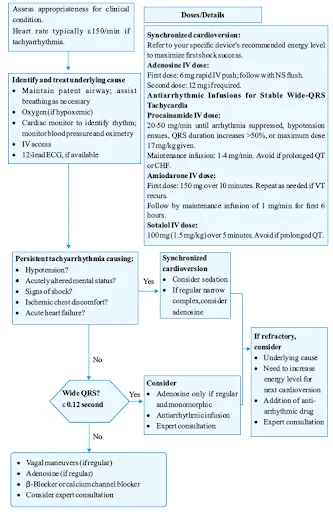Compare & Recall: High-Yield Anesthesia Tables for NEET PG
Jul 16, 2025
Navigate Quickly
Table 1
Regional Anesthesia
Table 2
Comparison of Spinal and Epidural Anesthesia
Table 3
Non- depolarising muscle relaxant drugs
Table 4
Full Review of General Anesthesia
Table 5
Airway Devices
Table 6
Sizes of LMA
Table 7
Lemon's Law
Table 8
Indications of ventilator
Table 9
Concentration of lignocaine in various anesthesia techniques
Table 10
Reversible causes of Cardiac arrest
Table 11
AHA algorithm for Tachycardia Management
Table 12
Parts of Anaesthesia Machine

Table 1
Regional Anesthesia
Peripheral nerve block Central neuraxial blockade Brachial plexus block
Stellate ganglion block
Celiac plexus block
Femoral plexus blockSpinal anesthesia
Epidural anesthesia
Caudal anesthesia
Saddle anesthesia
Table 2
Comparison of Spinal and Epidural Anesthesia
Parameter Spinal anesthesia Epidural anesthesia Onset Fast Slow Duration Limited duration Prolonged duration (as a catheter is used) Headache Present Rare Post-op pain relief Very low Fast Technique Easy Difficult Quality of block Dense Incomplete or patchy because the drug diffuses Complications t Hypotension- Most common
Causes sympathetic blockleading to reduced venous return and cardiac output
Table 3
Non- depolarising muscle relaxant drugs
Steroidal (-curonium) Benzylisoquinolinium (-curiums) Ends with curoniumo Pancuroniumo
Vecuroniumo
RocuroniumEnds with curiumo
Atracuriumo
Mivacuriumo
Doxacuriumo
Cisatracurium
Table 4
Full Review of General Anesthesia
Condition IV induction Agent Muscle Relaxant Inhalational Agent Heart disease Etomidate Vecuronium Desflurane is best butIsoflurane is commonly used Asthma Ketamine Any muscle relaxantcan be given Sevoflurane (reduce airwayresistance) > halothane Shock Ketamine Pancuronium Desflurane is best butIsoflurane is commonly used Day caresurgery Propofol Mivacurium Desflurane is best butSevoflurane is commonly used Neurosurgery Sodium thiopentone Any muscle relaxant canbe given Isoflurane
Table 5
Airway Devices
Temporary airway device Permanent airway device Used if permanent airway device insertion fails or is difficult.
E.g. Laryngeal mask airwayInserted directly into the trachea
Only lungs are ventilated
Prevents aspiration
E.g. Endotracheal tube
Table 6
Sizes of LMA
Size Weight of the patient 1 <5 kg 1.5 5-10 kg 2 10-20 kg 2.5 20-30 kg 3 30-50 kg 4 50-70 kg 5 70-100 kg 6 >100 kg
Table 7
Lemon's Law
Evaluation Criteria Points L = Look externally Facial trauma 1 Large incisors 1 Beard or moustache 1 Large tongue 1 E = Evaluate the 3-3-2 rule Incisor distance - 3 finger breadths 1 Hyoid mental distance - 3 finger breadths 1 Thyroid-to-mouth distance - 2 finger breadths 1 M = Mallampati (Mallampati score > 3) 1 O = Obstruction (presence of any condition suchas epiglottitis, peritonsillar abscess, trauma) 1 N = Neck mobility (limited neck mobility) 1 Total 12
Table 8
Indications of ventilator
Invasive Ventilator Non-invasive Ventilation Increasing respiratory rate
Asynchronous respiratory pattern
Change in mentation or level ofconsciousness (GCS < 8)
Hypercapnia and respiratory acidosis
Hypotension and atrial dysrhythmiasAcute exacerbations of COPD
Cardiogenic pulmonary edema
Obesity hypoventilation syndrome
Table 9
Concentration of lignocaine in various anesthesia techniques
Technique Concentration Intravenous regional anesthesia 0.5% Nerve blocks / Epidural 1-2% Topical 2-4% Spinal Spinal 5%
Table 10
Reversible causes of Cardiac arrest
5Hs 5Ts Hypovolemia
Hypothermia
Hydrogen ion (acidosis)
Hypokalemia
HyperkalemiaCardiac tamponade
Coronary thrombosis
Tension pneumothorax
Pulmonary thrombosis
Toxin
Table 11
AHA algorithm for Tachycardia Management

Table 12
Parts of Anaesthesia Machine
High-pressure system Intermediate pressuresystem Low-pressure system Cylinder
Yolk valve assembly
Pressure gauze
Pressure reducing valveOxygen and Nitrogenproportioning devices
Flow control valve
Oxygen flush
Central supplyVaporizer
Rotameter
Common gas outlet
Download the PrepLadder app now and unlock a 24-hour FREE trial of premium high-yield content. Access Smarter Video Lectures also in हिंglish, Game Changing Qbank, Audio QBank, Structured Notes, Treasures, Mock test for FREE to ace your NEET PG preparation. Elevate your study experience and gear up for success. Start your journey with PrepLadder today!

PrepLadder Medical
Get access to all the essential resources required to ace your medical exam Preparation. Stay updated with the latest news and developments in the medical exam, improve your Medical Exam preparation, and turn your dreams into a reality!
PrepLadder Version X for NEET PG
Avail 24-Hr Free Trial
